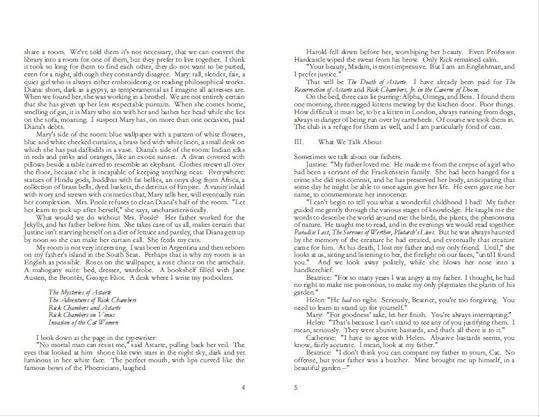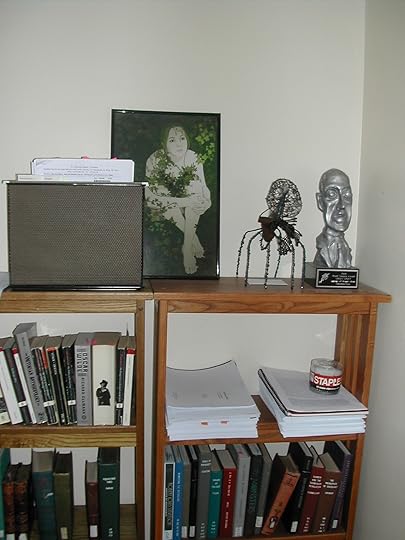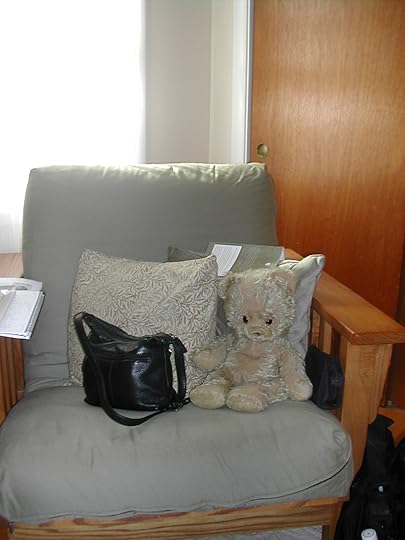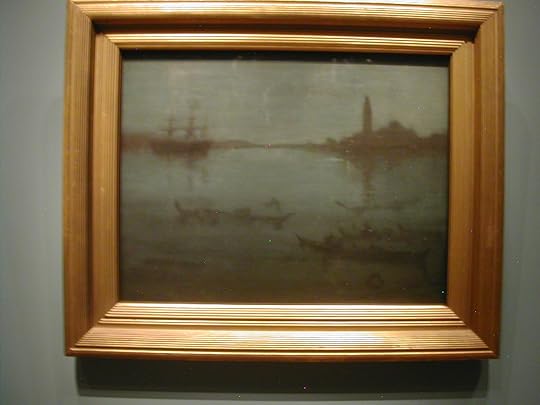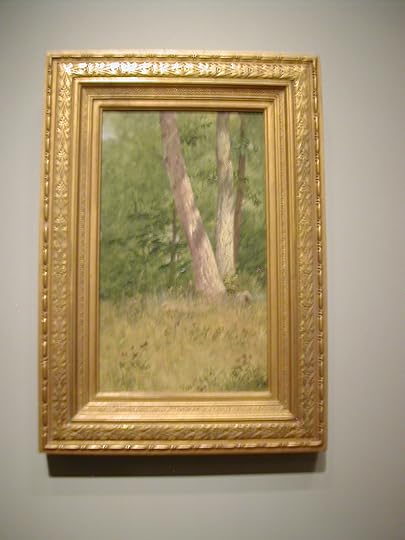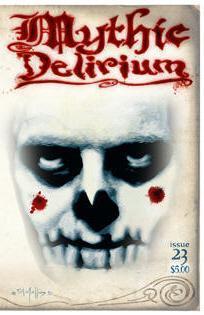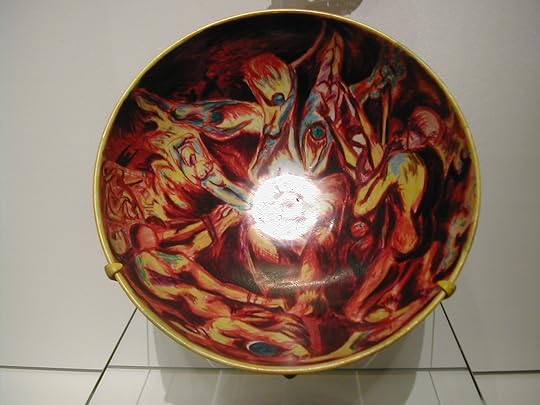Theodora Goss's Blog, page 74
December 19, 2010
Making a Booklet
So I was talking to a friend today about readings, and I said to him, you know what I like to do? I like to read part of a story and then pass out copies of a booklet with the whole story in it. That way, the audience members can read the whole story, and if they want you to sign something, they have something for you to sign right there. And it's fun to have something that they're not going to get anywhere other than at that reading, something they can't buy. Something the writer made.
He liked the idea and asked me how I created booklets, and honestly, I could barely remember. It's been a while. So just to try to remember, I made one out of my story "The Mad Scientist's Daughter," which you can read on the Strange Horizons website. It took me a long time to remember how. But here's what it finally looked like:
This is just three pages, to give you an idea. (Why are the page numbers on the insides? Because when I actually print the booklet, they will be on the outsides. You tell the program to print a booklet, and somehow it rearranges everything during the printing process.)
Here's the problem. I can do something like this in my favorite word processing program, which is (don't laugh) WordPerfect 11. I think it's the most perfect word processing program ever created. Simple, clear, clean. Sort of like a typewriter with word processing capabilities. I have a deep and abiding hatred for MS Word, which I find frustratingly clunky to use.
But it takes me a while to format and print a booklet like this one. What I would really like is a program that would let me create a booklet simply, easily. As easily as I created this website on WordPress. If you know of one, will you tell me? I don't need all sorts of advanced publishing capabilities. I just want to be able to make a booklet for readings.
So I was telling my friend, who is of course a fellow writer, to think about the psychology of a reading. What can you do that will make your reading stand out, that will make people want to come and then remember it afterward? I used to do two things. First, I used to let everyone know that at my reading, there would be chocolate. (And of course there was.) And then, I used to give away booklets, as I've described. I think I'll do that again this year at Readercon, which is one of my favorite conventions. (I just received the invitation, and I will most definitely be there.) Those two things gave people something to do at the reading in addition to just listening, and then something to take away.
So I'm glad I remembered how to make booklets. Now the question is, how do I do it more easily?








December 18, 2010
The Hotel Under the Sand
"So awful things happen sometimes, but good things can happen too. The trick is to be as brave as you can through the terrible parts so you can get to the wonderful ones, because they will come along someday," said Masterman.
"That's true," said Emma, looking around at the Grand Wenlocke.
"And when they come, you have to remember how to be happy again," Masterman added. "That's very important."
"But you can't ever forget the people you lose, can you?" said Emma.
"Of course not," said Masterman. He picked up his water glass and held it up. "Here's to making them proud of us!"
Those lines are from The Hotel Under the Sand, by Kage Baker. I finished it today, and I think it's one of the best books I've read recently. Why do I like it so much? Partly because it's a strange and beautiful story, and partly because of the writing. It's deceptively simple, but also lyrical. It gives off a beautiful tone, like a glass bell. It's my favorite kind of writing, straightforward and clear, with a certain lucidity, delicacy, humor. And the story itself is wise.
I'd read two of Kage Baker's stories before, and I have to admit that I'd thought of them as relatively ordinary science fiction stories, although better than most. I picked up this book at the World Fantasy Convention, partly because I liked the title and the cover image of a pair of feet in the sand. Here it is:
And I probably opened the book and read the first few paragraphs, because I tend to do that. It begins,
Cleverness and bravery are absolutely necessary for good adventures.
Emma was a little girl both clever and brave, and destined – so you might think – to do well in any adventure that came her way. But the first adventure Emma had was dreadful.
One day a storm came and swept everything away that Emma had, and everything that Emma knew. When it had done all that, it swept away Emma too.
Isn't that a wonderful way to begin a book? It's certainly a way that will engage me at once, because I want to know what happens to little girls who lose everything, even themselves. I don't want to tell you too much about it, but it's the perfect book to buy for yourself, or for anyone you care about. The perfect present. If you're interested, you can order it from Tachyon Publications or Amazon.
In my last post, I talked about learning from other writers, and this is an excellent example. From The Hotel Under the Sand I learn that one can still write like this, in a style that reminds me just a little of E.B. White, but more fantastical. And I learn how: I look at the sentences and ask, how are they constructed, how does Baker achieve that ease, that effortlessness? And I see where the story places itself, in that liminal space I talk about, where Edward Gorey was working. (The Hotel Under the Sand reminds me just a little of Edward Gorey with sunlight. With a happy ending.) And it makes me ask, what in a story gives us pleasure? And helps me to see what does.
Like most well-brought-up children, she had always wanted to shoot off a real cannon.
Isn't that a wonderful line?








Engaging the World
If you're interested, my blog post "Why Go to the Museum?" was recently reposted on the SFWA blog. If you missed it the first time, feel free to go over and take a look!
Having my post reposted made me think about the importance, for a writer, of being engaged with the writing world – the world of other writers.
We don't necessarily think of writers as engaged, do we? We think of Marcel Proust in his cork-lined room, the solitary genius sequestered from the world. We don't necessarily think of writing as a collaborative activity. And yet – I think of the fact that Proust translated the works of John Ruskin into French. There's a way in which, if you're a writer, you have to be engaged with the world of other writers, whether past or present – and so much the better if both. You have to allow yourself to be influenced, to feel the words of other writers, their ideas, their style, affecting you, forcing you to think about what you're doing. That's not going to the museum – that is, in a sense, going to the library, even if it's just your own personal library.
But I, personally, need more than that as well. I need to spend time with other writers, sit down with them, talk to them, find out what they're doing. I need to hear about their projects and their lives, exchange manuscripts with them. That's what I get from being on facebook, reading writers' blogs, going to conventions. And from maintaining personal relationships, even if it means I'm emailing friends I only see once a year. It's also what I get from being a member of SFWA. (My dues are due at the end of this month. Note to self: pay SFWA dues!)
Because writing is, almost always, a collaborative activity. When I wrote "Miss Emily Gray," I collaborated with Henry James. When I wrote "Pug," which is coming out in Asimov's Science Fiction, I collaborated with Jane Austen. We are all writing mash-ups, all the time. Most of them are just more subtle than Pride and Prejudice and Zombies.
But talking to other writers, reading what other writers are working on this year, in this century of ours, gives me a sense of my own possibilities. There's a piece of advice writers are often given, which is to pay no attention to how your contemporaries are doing. That will just, we are told, create discontent. But I do pay attention, and I pay attention specifically to writers who are doing things I'm not, at least not yet. I'm thinking of writers like Nnedi Okorafor, Catherynne Valente, and Chris Barzak. Nnedi and I went to Clarion together, and over the years I've seen her publish short stories, then novels – amazing, inventive novels that address important social issues, even though they are also rousing adventure stories. I met Cat years ago in an airport, while we were both headed to Wiscon. I've seen her create a world for herself, a fascinating world in which she writes poetic novels that are unlike anyone else's, puts on fabulous shows with S.J. Tucker, and wears the most fantastic clothing. I met Chris at Clarion, although he had already graduated; he was just back to visit. I read a story of his back then, and it's been fascinating to watch him refine the style he had into something so direct, lyrical, and affecting. His stories seem to speak directly to you (at least, they do to me). Nnedi, Cat, and Chris are all being successful in their own ways, and watching them makes me think about what I want to do, how I want to be successful. Because their successes reflect their individual personalities, and so I have to think about what I can do that reflects mine. I could not be successful in their ways. But they give me a sense of the possibilities out there.
(If you haven't read their stories, you'll find links to their websites on this page. Go buy their books! You still need to buy presents, don't you? If not for others, then for yourself.)
But I called this post "Engaging the World," and that sort of engagement is not a passive activity. It doesn't mean simply paying attention to what other writers are doing. It means going out there (which many writers are not very good at doing – many of us are like deer, and prefer to stay in the shadows at the edge of the forest), joining organizations, being on panels at conventions. Putting your own ideas in front of the world, being willing to say what you think. Especially about writing, about where it is nowadays, where it needs to go. That takes a certain level of courage, because you will be contradicted and someone, and maybe a lot of someones, will say you're wrong. And you may be.
But I think it's important for writers to be engaged, with the world of other writers and, beyond that, with the world of their readers. Because the readers are what it's all about, finally. (If you're a reader, you're what this is all about, finally. If I don't reach you, if I don't engage with you, I've failed.)
Reading this post over, trying to correct misspellings, mistakes, I realize how much more random it is than my usual posts. That's because there's a though behind it that I haven't expressed, that I've withheld from you. It is this. I met a writer recently, one of the most talented I've met, who is not engaged in this way. And who, therefore, is not in touch with other writers or readers, and misses opportunities to make his writing stronger, and misses publication opportunities, and opportunities to bring his writing to readers who would enjoy it, be touched by it. He will never read this post, because he doesn't read such things, so it's as though I'm writing it completely in private, even though it can be read by the entire world. And so this post is a form of mourning for missed opportunities, for him and other writers I've known like him who are not engaged, and do not know their own possibilities. And it is a reminder to myself, and to you who are reading this, to engage, even when we feel like curling up in bed, under the fuzzy blanket (pictured in my last post, if you remember).








December 17, 2010
My Work Space
Terri Windling is one of my favorite writers and one of my favorite people in general (if she is a person, which I have long doubted – I suspect she's really the Fairy Queen in her mortal form). She has the most wonderful blog, and as soon as you look at it, you will realize that I stole the idea of William Morris wallpaper (get it? wallpaper!) from her, although mine is a sort of sage rather than taupe.
Well, Terri has a wonderful series on the blog, in which she is asking people to photograph their desks and posting the photographs. If you scroll down this post, you will see my desk.
When I saw this picture, I was a little sad, because my work space is so much sparer, and I have to admit so much more boring, than the work spaces of other people she's featured. It doesn't quite look like the work space of a creative person, does it? But it is what it is, and I thought on my own blog I would post some more pictures of where I work. Here they are:
These are two of my shelves, and you can see how messy they are. On top I have notebooks with stories I'm working on, and a picture I haven't yet hung up. That small black box is filled with contact information for people I know in the writing world, people I've met at conventions, etc. It's my box of professional contact information. I suggest that every writer have one.
Two more of my bookshelves, with Mr. Lovecraft Head (yes, that's my World Fantasy Award) and one of the most wonderful presents anyone has ever given me, the poet Elah Gal from "Child-Empress of Mars" sculpted by C. Jane Washburn. Also another picture (a digital one) I have not yet hung up.
And another view of the same shelves, showing the all-important basket with a fuzzy blanket in it, which I wrap around myself when I'm reading. These shelves, by the way, are currently my dissertation shelves, meaning that they are filled with library books and copies of my manuscript. May they someday be put to a nobler use!
This is the comfortable chair, with Dani, the bear I received for my first Christmas, and a pillow I sewed from William Morris fabric (can you see a theme emerging?), and my purse. (No, I did not straighten anything before taking these pictures. Perhaps I should have.) The book on the pillow is Kage Baker's The Hotel Under the Sand, which I am currently reading. The books on the arm of the chair are a set of John Carter of Mars novels, which I'm using to research a story I'm currently writing, on top of the notebooks in which I'm writing the story.
This is my desk, which was also shown on Terri's blog. The CDs stacked on the shelf, by the ancient boombox I salvaged from the basement of the apartment building where I used to live, are mostly Loreena McKennitt, music from the Renaissance, or experimental modern music (Eric Satie, Arvo Pärt, Morton Feldman).
And panning over, you get to . . .
My other desk, where I do anything that does not require a computer. The cabinet holds writing supplies, and in front of it is my new favorite thing in the world, my space heater. Because in a drafty old house in Massachusetts, it is never, ever warm enough.
And there you have it, my work space. If I owned this house, it would probably be fancier in some way. But it's functional, and here I write my stories and poems and essays. I suppose finally that's what counts, the output. Right?








December 16, 2010
One of Those Days
It's been one of those days. This morning I discovered that my laptop has been infected with spyware, so I can't use it until the spyware is removed. As a result, I could not do any work that required a laptop. I have a netbook, on which I am typing this post, but it's too small to type on well, and for someone who's used to touch-typing rather quickly, it's almost impossible to use for serious work. So I spent the day doing work for which I did not need a laptop: writing by hand part of a story I've promised to an anthology, and then reading through the first chapter of my dissertation. I need to revise the second chapter in the next two weeks, but in order to do that, I need to understand what I wrote in the first chapter. And I need to revise that as well. The final section on anthropology and the monster is not as strong as I want it to be.
So what to do? I promised myself that I would post every day, but my brain is empty of anything interesting and filled with all sorts of things you probably don't want to read about. Except that I did have some ideas about poetry, coming from having read some of the poems in Mythic Delirium 23.
Recently, I read a blog post about the best poetry books of 2010. It included some of the best lines from each book, and as I read them, I could feel a sort of sinking sensation. Based on those lines, there was almost nothing on the list that I would enjoy reading. And I thought, as I usually do when it comes to poetry, that it must be me – I must just have terrible taste in poetry. (Although I did want to read the Paul Muldoon and a new edition of Ezra Pound. Those sounded interesting.) I mean, when I read a standard Norton anthology of poetry, I love almost everything in it. And I love early modernism, Eliot and Auden and those guys. Even quite a lot of Stevens. And then something happens, and I find very little that I love anymore. Some Anne Sexton. Some Sylvia Plath. But so much of it goes flat for me.
But I do know what I like, what I respond to. As examples, I'm going to give you stanzas from two poems, both published in Mythic Delirium 23.
Ovid's Two Nightmares
by Sonya Taaffe
Not like Odysseus to his wife's ever-olive arms
nor like Agamemnon to the unapologetic knife
I return, the patron of exiles repatriated
windburned, ink-stained, grey-haired as the sea
tossing chips of rime on a black shore,
old Daedalus disbelieving the labyrinth's fall.
So many spilt words, so many missteps
like across my hands like shadows in the afternoon,
ripening lemon and bay, the grape's bitter leaves.
So many ghosts sent begging for salt and violets
hang back quivering in the August sun.
She Who Rules the Bitter Reaches
by C.S.E. Cooney
In avalanche silence, the unceasing breezes
Sculpt from the mountain a luminous keep
Lay carpets of snowflake and beds all of diamond
Preparing a nest for the Winterbird's sleep
Here she will live, in an ice-blooming vastness
Her breath forming opal of flesh and of stone
Here she will rest in this radiant fastness
A splendor of silver and feather and bone
If you want to read the rest of these poems, you'll have to order Mythic Delirium 23 . . .
What I want poetry to do, those two poems do for me. They send me somewhere only poetry can send me, to a place that is like the top of a mountain, where the air is clear. They give me a sense of joy, almost of ecstasy, as though my mind were dancing. That's what I want from poetry. I don't want it to make me think, although it can do that too. I want it to make me feel life coursing through me, as though I were breathing clear air at the top of a mountain, as though I were suddenly completely alive.
(Technically? In Taaffe it's the progression of the vowels and consonants: spilt, missteps. The way she arranges her vowels and consonants, that's the technical basis for the sensation the poem produces. In Cooney it's the rhythm, which is both regular and irregular, so that you're constantly juggling its irregularity, struggling to read it as regular. I'm not sure why, but that's a strong source of poetic pleasure.)
I think it's important, if you're a writer, to point out what you think is good, what gives you pleasure. It's a way of having and continuing a dialog about what is worthwhile in art. I started that with my last post about modernism, didn't I? And I suspect that I'll continue it. After all, I'm pretty opinionated about these things.








December 15, 2010
Just Before Modernism
Why is the period just before modernism so important to me? I was watching a show on PBS about Paris in the modernist period. When I turned the television on, it was already on the friendship between Braque and Picasso. I stopped watching at Duchamp.
The art, the poetry, the Paris scene, all were magnificent. But it was as though, despite its magnificence, or perhaps because of it, I had no use for modernism. It was already complete in and of itself, it had already achieved the highest it would achieve. And I could do nothing with it.
I think I keep going back to the period before modernism because it still feels incomplete, filled with possibility. It's still the beginning of something, rather than the fulfillment of it. I find more inspiration in an art nouveau fan than in Les Demoiselles d'Avignon.
I was looking through my photographs from the Museum of Fine Arts and found a few more paintings that I would put in Mother Night's house:
Compared to Picasso, these paintings are pleasant, painterly, tame. And yet they inspire me to write things, whereas Picasso stops me from writing. And in a way, they rather than Picasso are the precursors to an artist like Patrick Dougherty.
Perhaps they represent to me a world in which fantasy is still possible, whereas by the time we get to Picasso and Braque, that world seems to have passed away, as though World War I had killed all the fairies.








Miss Lavender's School
We all came to Miss Lavender's for different reasons, and in different ways.
Emma came because the Gaunts had always come to Miss Lavender's. Her mother had come, and her mother's mother, and her mother's mother's mother, all the way back to the Conquest, when Marguerite de Gaunt insisted on enrolling despite her father's opposition. Back then, Miss Lavender's was one of the few schools that accepted both Normans and Saxons. When I say the Gaunts are wealthy, I mean that they are very, very wealthy. We've all been to their house in Concord and their other house on Nantucket. They've made their fortune in every way possible: whaling and railroads and silicon chips. And don't they know it! Except for Emma, who is refreshingly normal. I mean, I was worried about sharing a room with a Gaunt.
Matilda came because she had to. Her father was a Tillinghast, and the Tillinghasts are almost as old a witch family as the Gaunts. But he decided that instead of managing the family business, he was going to be an artist. And then he married another artist. His parents had died when he was young, and he had been raised by his aunt, old Matilda Tillinghast, in a large house near Boston Common. She believed in duty to one's family, not in going off to North Carolina and painting what she considered ugly, muddy landscapes. So she cut him out of the will. That was all right, until he got sick with one of those illnesses that take all of your money if you haven't got health insurance, which he didn't. And so he died, and Matilda's mother had no money and piles and piles of hospital bills. And then one day she received a letter from old Aunt Matilda saying that she would pay to send young Matilda to Miss Lavender's, and if she did well, she would be written back into the will. No wonder Matilda was in a terrible mood the day she arrived.
Mouse came because she was hiding out. I've told her story elsewhere, in "Lessons with Miss Gray," but I left out a couple of things. Like that her father was a powerful warlock who had gone very, very wrong. Her mother was one of the Wild Women of the Forest, the ones who dress in white and wear shoes of bark. Miss Emily Gray rescued her and brought her to Miss Lavender's. She wasn't actually a witch – witches are always human, and she was only half that. She was more like her mother than her father anyway. But Miss Lavender's was the one place that Miss Gray could look after her and protect her.
And why did I go to Miss Lavender's? The Graves are an old witch family too, although nothing like the Gaunts or Tillinghasts, or even the Sitgreaves before the scandal. And my guardian sent me. "Thea," she said, "Mrs. Moth is willing to offer you a scholarship. It's Miss Lavender's or the public high school, and we both know what that's going to be like." Exactly like the public middle school: more eating lunch alone and "Hey, Graveyard. Seen any ghosts lately?" That's what it was going to be like. Being from a witch family doesn't exactly make you popular in rural Virginia. So I went.
And it's a good thing too. I don't know what Matilda, Emma, and Mouse would have done without me. (Just kidding. They would have saved the world just fine. But I'm glad I went. I would have missed out on so much, if I'd stayed in Stone Gap! And I wouldn't be here in Boston, writing about it for you.)








December 14, 2010
Ask the Cats
"Ask the cats."
"That makes no sense," said Matilda Tillinghast.
"But that's what it says. Do you see a cat anywhere?" Matilda's mother started looking around them, at the sidewalks and the brownstone steps, into the alleys between the buildings.
"Mom, give me that." Matilda took the piece of paper from her and looked at it again. Directions to Beacon Street, right across from the Boston Common, and then to Hecate Lane. And below the directions, a final sentence: "If you can't find the entrance, ask the cats."
"It's supposed to be between these two house, but there's nothing. Just one building next to another. Tildie, look for a cat."
"Mom, that's so stupid. How's a cat going to help us?"
Mrs. Tillinghast stood up, looked back at Matilda, and said, "You're going to have a lot to learn at Miss Lavender's. I wish your father were still with us. I don't know enough to help you understand, but I do know enough to follow directions, no matter how strange they might seem. So make yourself useful and look for a cat, right now."
"Did you require some assistance?" It was a black cat, sitting on the steps of a brownstone, where Matilda could have sworn she had not seen one a minute ago.
"Yes, we're looking for Hecate Lane," said her mother. It had been such a strange day anyway, arriving in Boston by train after leaving North Carolina last night, sleeping dressed and upright in the train seats, and then taking the subway to the Common, dragging two suitcases with all her clothes, everything she would need for school – she was so tired and irritated at the strangeness of it all – that it took a moment for what had just happened to register. A cat had talked to her mother. And her mother had talked back.
"Follow me," said the cat. It climbed down off the steps and then led the way to – well, now there was an alley between the buildings, with a wrought-iron gate that had a small plaque on it saying Hecate Lane. The cat slipped through the bars at the bottom. Mrs. Tillinghast opened the gate and said, "Come on, Tildie."
Matilda looked back at the Common, at the green trees and the statues, at the swank brownstones that lined the streets, at the skyscrapers rising in the distance. This was nothing like Ashton, North Carolina. For the first time that day, she began to feel, not just tired and irritated, but also a little sick.
Dragging one of the suitcases, she followed her mother along the alley between the buildings. Brick pavement between brick walls, until the brick walls ended and then the brick pavement was walled only by hedges, over which she could see a grassy space with tall trees. It was like a small park in the middle of the city, hidden among the buildings. And in the middle, under some of those trees, there was a stone house.
The cat led them up the pavement and to the front door of the stone house. Then it turned and said, "I knew your husband, Mrs. Tillinghast, when he was doing his apprenticeship. He was a good student, although he once accidentally set my tail on fire. I'd like to offer my condolences."
"Thank you," said Matilda's mother. But the cat was already gone.
She knocked on the door while Matilda did her best to get the suitcase she had been dragging up the stairs. The door was opened by a girl with short blond hair, in a green dress. She was by far the prettiest girl Matilda had ever seen. Matilda disliked her already. "Mrs. Tillinghast? We've been waiting for you. And this must be Matilda. I'll show you to your room, and then you have an appointment with Mrs. Moth."
She could at least have offered us something to drink, thought Matilda as she climbed the stairs, the suitcase banging behind her. But when they reached the room, the girl said, "Lemonade and cookies." And there they were, lemonade in a pitcher and a plate of cookies, both on a table around which were sitting three girls.
"Hyacinth, which day is laundry day?" asked one of the girls. She had brown hair and was a little plump.
"Have your clothes in the baskets by Thursday, and they'll come back by Friday. Girls, I'd like you to meet Matilda Tillinghast. Matilda, this is Thea, Emma, and Mouse."
"Tillinghast?" said the plump girl, whom Hyacinth had introduced as Emma. "I know your aunt. Isn't your father the one who –"
"Nice to meet you," said Thea. She had red hair and freckles. "Cookie?"
"Sure," said Matilda. Mouse held out the plate. One more strange thing on this strange day: Mouse was the palest person Matilda had ever seen, and her hair was as white as snow. Her eyes were a startling light gray.
"We're supposed to see Mrs. Moth, right?" said her mother. "Bring some cookies with you. We haven't had time for breakfast," she explained to Hyacinth.
"Thanks," said Mathilda, trying not to stare at Mouse. So this was her room. This was going to be her room for the entire school year, with three girls she didn't know and already didn't particularly like. Unless of course she decided to run away, which was a distinct possibility. As she followed her mother down the stairs, finally without the weight of the suitcase behind her, she felt sicker than ever.








December 13, 2010
Writing Poetry
I had an interesting, writerly sort of day today. It wasn't supposed to be a writerly day, actually. I started the day by grading final portfolios for my classes, and then went into the university to meet with a student and pick up a few portfolios that were coming in late. But before I sat down to grade this morning, while I was eating breakfast, I fiddled with a poetry collection that I'm supposed to be working on, trying to figure out how to get the poems in the right order within their sections. Trying to find a logical flow from poem to poem.
And then, after meeting with the student, I drove to Harvard Square and went into my favorite stationary shop, Bob Slate, which makes the notebooks I use for writing. Spiral bound, narrow ruled, with Bob Slate Stationer written on the cover. And I bought some notebooks, also Bob Slate, small enough so they will fit into my purse. I still remember being in the museum and having nothing to write on. That's not going to happen to me again.
Then I drove home and found a couple of things in the mailbox: the new Locus, a Locus subscription renewal form (which I will of course fill out, because I cannot live without Locus), and Mythic Delirium 23, which you can order through the Mythic Delirium website. Here's what it looks like:
I particularly like this cover because it goes with one of the two poems I have in the issue, "Death." The other poems is called "As I Was Walking." "Death" is a love poem that begins,
The night has gathered around me. I think of Death,
Who breathes so softly beside my ear, like a lover.
Softly he whispers, "This will soon be over.
You will lay those bones and heavy body down."
All my poems about death are personifications, and all of them are love poems. Not because I'm a particularly grim person, I think, but because of all the bad boys out there, Death is the baddest of them all. Don't you think?
Why do I write poetry? For the fame and fortune, of course. (Are you laughing?) But seriously, I write poetry because it's in me, and if I don't get out the things that are in me, I become sick. I think I'm sick now because I have so many stories inside my head, and they're making my head hurt. And I have poems in there too, although fewer than I used to. But I would like to write more.
Yes, I did mention that I'm trying to put together a poetry collection. (Did you pick up on that?) I don't know how it will turn out, and although I have confidence in my prose, I don't have the same confidence in my poetry, primarily because of some negative experiences in undergraduate poetry classes. (Evidently it's fine to write about a Buddhist monk wandering around a hardware store, but not about a woman who, one day, discovers that dragons have moved into her apartment. Small ones. "They got tangled in the hangers." I still remember that line.)
So I'm fiddling and worrying, worrying and fiddling, wondering if I can be excused from writing Significant Modern Poetry if I come out and say, "Look, this is in the tradition of Walter de la Mare, not T.S. Eliot." After all, Jane Yolen and Neil Gaiman write poetry that has a mythic dimension, that has in fact appeared in Mythic Delirium. I'll just go sit at their table, thank you. Where we write poems about witches and ogres, and how to survive fairy tales, and all that sort of stuff.








December 12, 2010
Pollock's Drawings
When we were at the Museum of Fine Arts, I took some pictures of drawings by Jackson Pollock. It was only later that Kendrick, who had read the signs underneath them, explained to me what they actually were.
The first item I saw was not a drawing but a ceramic plate decorated by Pollock:
How strange, I thought, that a serious artist would decorate a plate. But then, at one point Picasso had painted jugs. Perhaps those sorts of things, decorator items, paid well. No, Kendrick said. When he painted that plate, Pollock already had serious mental problems, as well as problems with alcoholism, and a friend told him to try painting on ceramic. So that plate was an attempt to deal with his problems, to get better.
And the drawings, well, they were actually made after he entered a mental institution and started Jungian psychotherapy. They were a part of his therapy. Here they are:
I'm not entirely sure why these struck me so much. I suppose because they made me think about what it's like being an artist of a certain sort. (I make no claim that every artist is like this, only that some are.) There are certain artists whose underlying sensitivity, vulnerability, instability allow them to access certain ideas in a particularly direct way. I think of Van Gogh and Lovecraft, different as they are, as both being in this category. Paradoxically, it's the art that also helps them deal with those particular aspects of their personality. So the temperament of the artist poses a problem that the art itself helps with. There is something in Van Gogh, Lovecraft, Pollock: their work seems to expose an underlying darkness, and a dark order, at the center of the universe. Even Van Gogh's sunflowers are touched by that darkness. It's as though these artists intuited something. In Lovecraft it comes out as shuggoths, which can seem silly. But the sense he has of the universe, of the way it works, the way it's founded on a sort of chaotic order – I relate that to Pollock's paintings.
Again, not all artists are like this. Many of them are perfectly sensible, cheerful, productive people. But there is a place, for certain artists I think, where art both causes the pain and is a rescue from pain. It's profoundly paradoxical, and difficult to deal with I would imagine. Because I can only imagine myself a little way into Pollock's world, or Van Gogh's world. I can imagine myself better into Lovecraft's, perhaps because I'm a writer myself. But Pollock's plate and drawings really struck me, and I thought about them long after we left the museum.











